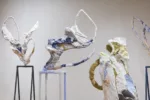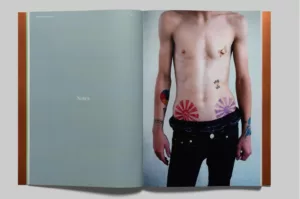By Miles Orvell
Walking into “Site Unseen,” an exhibition of new work by photographer Laurence Salzmann and sculptor John Schlesinger, we are at once in an art laboratory, a gallery, a construction site, and a stately Victorian twin at 3610 Baring Street in West Philadelphia, not far from where the artists happen to live. Few shows have ever joined their place of creation and their exhibition space in quite this way.
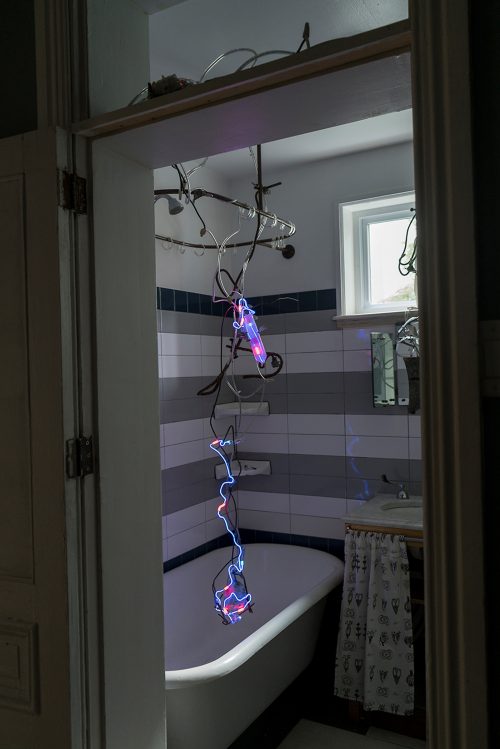
Both artists–whose work has been collected by many museums over many years–started with found materials: Salzmann with wallpaper from the house itself, removed during its renovation in 2015, and Schlesinger with assorted discarded industrial materials, which became ingredients for his on-site constructions. The challenge of work that starts with real things is twofold: the artist must not leave the thing untouched, at the risk of producing a banal reframing of the objet trouvé (no point repeating Duchamp on this); conversely, it must not overwork the object, disappearing it into the new art work as if it has no presence of its own. Salzmann and Schlesinger, in their different ways, each beautifully confirm the relevance of the Goldilocks principle, effecting an appropriation and transformation that is just right in respecting the materiality of the original thing while at the same time incorporating it into the artist’s conception.
Salzmann’s starting point was the wallpaper in the house, salvaged during the renovation process. Wishing to preserve the material from ruin, Salzmann selected hundreds of choice samples, which he photographed in color and printed in square dimensions approximately 21 inches per side. But in framing the pigment prints, Salzmann rotated the axis 45°, so that we are looking at diamond-shaped prints resting on one corner within a square black wooden frame. In thus escaping the formal expectations of horizontal and vertical format, and building on his Hasselblad square format days, Salzman focuses on the thing itself, set within a neutral square; and in rotating that square into a diamond shape, he creates an instability, a provisional balance, that frees the artist and the viewer to try out interpretations that are both formal and thematic. The photograph becomes a site of aesthetic play, a laboratory for thinking.
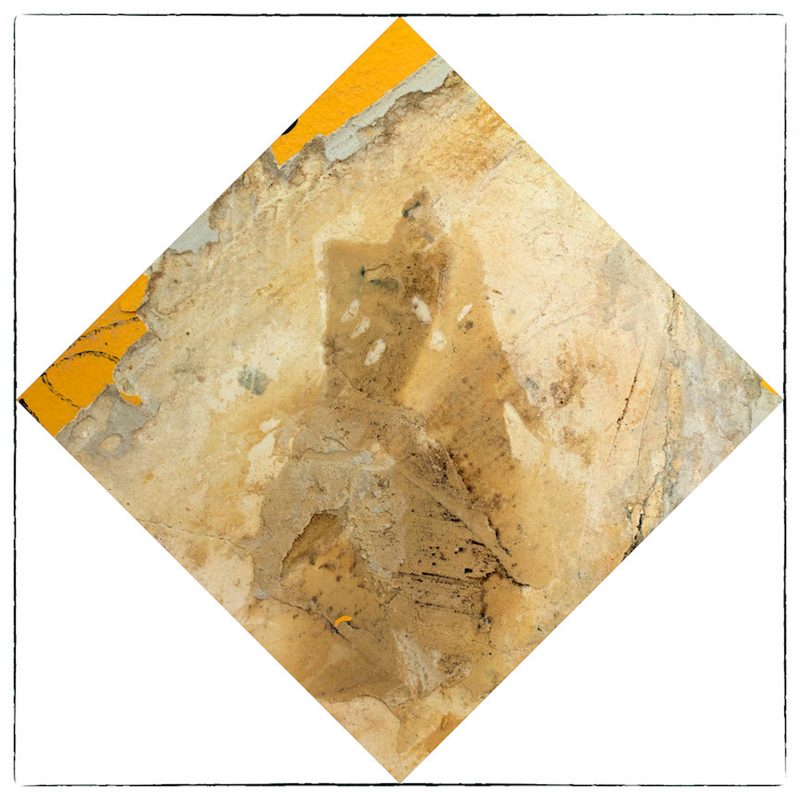
There is a thematic consistency to the series as well, for in creating these striking prints as aesthetic objects, Salzmann has taken materials that share the common quality of mass production and that bear the effects of wear, the rips and scars of outrageous fortune, the surface erosions and discolorations, that elevate them to the status of unique things. They are also singular evocations of a thought or mood or analogy or whimsy. (If there are two words that describe Salzmann’s imagination they are: methodical and whimsical.) The viewer looks at them and sees them as powerful abstractions, given shape and form by virtue of the photographer’s cropping; but we can’t resist seeing “real” forms in the shapes– a monk, a head of lettuce, a cape, a landscape at sunset, a murder scene by Weegee, an underwater sea bed.
Salzmann is best known as an ethnographic documentary photographer (he has portrayed communities in Mexico, Cuba, South America, Europe), and his work typically exhibits an intimate humanistic motive that is not immediately obvious here. But these photographs do in fact connect intimately with the building’s history and with the neighborhood; and the photographer’s eye for dynamic forms, whether in human movement, landscape, or wallpaper, is a constant.
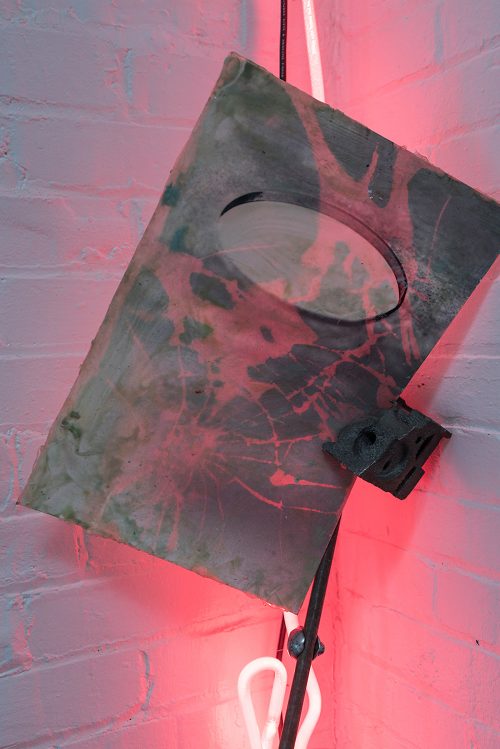
John Schlesinger’s work at Baring Street likewise connects with the history of mass-produced objects and with machine reveries. His sculptural creations occupy several rooms that resemble conventional exhibition locations and also spaces that are not (e.g. a bathroom, the front porch of the building, the basement). In each case, the work exists not simply as an object that might be seen anywhere, but as a site-specific installation that creates a kind of synergy with its immediate environment, picking up wittily on the immediate context–as in the bathtub neon that looks like water coming down from the shower head. These assemblages use found manufactured objects–laboratory glass, bronze and steel clamps, and especially salvaged rebar–as raw material, weaving them into a typically free form structure of neon lights. In many works, Schlesinger uses his own photographs of previous installations–encased in translucent amber resin–to add a two-dimensional plane to the composition; Schlesinger delights in the self-referential or “auto-cannibalistic” quality of these images, which look vaguely like X-Rays from Dr. Frankenstein’s failed medical office and seem to play at the boundary line between the organic and the mechanical. The shaped neon tubes–almost like drawn lines–are not only the driving force of these sculptures, but cast a colored light on the surrounding environment (brick wall, bathtub, corner space) that is integral to the piece. As site-specific as they seem, however, these “neon-hybrids,” as Schlesinger calls them, could theoretically adapt to other spaces.
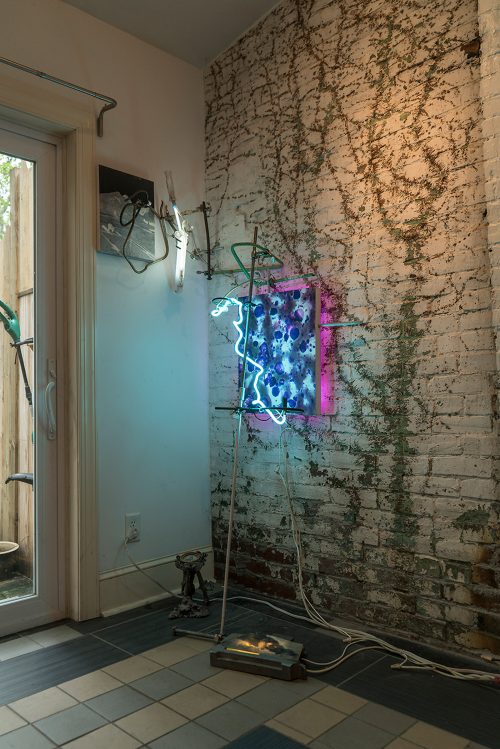
Schlesinger’s sculptures represent the culmination of an aesthetic practice and a career of several decades that began in photography and moved into three-dimensional forms. The integration of light, found materials, space, and two-dimensional images in these works is at once completely surprising and completely convincing, and their remarkable individuality becomes apparent the more you gaze at them. Schlesinger’s work might look superficially as if it had drawn inspiration from Yves Tinguely or Man Ray under the influence of Salvador Dali and Bruce Nauman, but each piece has an unpredictable structure that breaks the frame of expectation and draws us into its ambiguous space.
This show at 3610 Baring Street also features several photographic works by Oscar Reyes Tabares, a Colombian craftsman who also is now living in the neighborhood. And it is dedicated to the memory of Randy Dalton, a Philadelphia artist who died in 2016 and was known as “Mister Blue”–the color he wore and championed as an arts advocate. As much as it is an exhibition of intriguing new work by Salzmann and Schlesinger, “Site Unseen” reflects as well the creative energy of Powelton Village as a neighborhood for the arts.
Site Unseen, 3610 Baring Street. Through July 31, 2019, by appointment only. laurencesalzmann@gmail.com

Bio
Miles Orvell is Professor of English and American studies at Temple University, and is the author of The Real Thing: Imitation and Authenticity in American Culture, 1880-1940 (1989; 25th anniversary edition, 2014); American Photography (Oxford History of Art Series, 2003; revised edition, Photography in America, 2016); and The Death and Life of Main Street: Small Towns in American Memory, Space, and Community (2012), and other works. He is completing a book called “Empire of Ruins: American Photography and the Destructive Sublime.”



